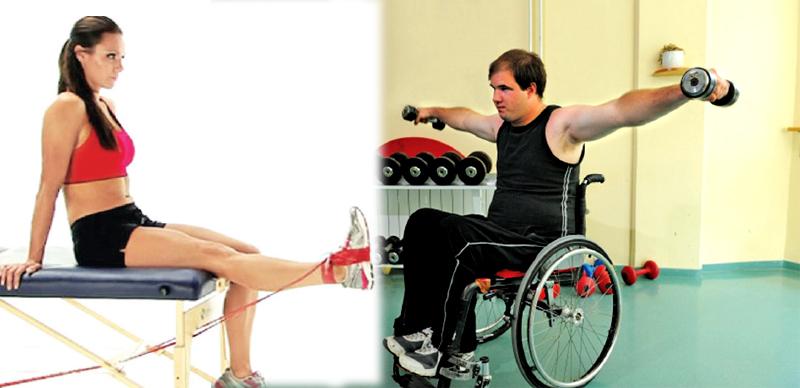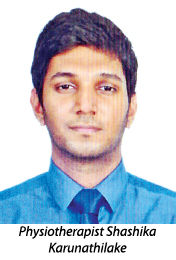
The recent reconsecration of the historic St Anthony’s shrine, Kochchikade which took a heavy beating in the Easter Sunday suicide bombing in April, showed moving photos of many victims still wearing bandages and on wheel chairs attending the tri lingual service conducted in the presence of many dignitaries. That they had braved the inclement weather and come to the very place where they had lost their loved ones showed great strength of character. Yet, the scars remain. Those trapped in wheelchairs or bereft of normal movements, have already undergone surgery. It is now left to nature and an alternative approach to holistic healing to quicken the healing of their damaged limbs and restore their normal movements.
 Physiotherapy holds the key to this fresh approach, says a Physiotherapist from a leading hospital in Kollupitiya, Shashika Karunathilake. He explains how this can be done in his interview with the Sunday Observer.
Physiotherapy holds the key to this fresh approach, says a Physiotherapist from a leading hospital in Kollupitiya, Shashika Karunathilake. He explains how this can be done in his interview with the Sunday Observer.
Excerpts…
Q. Footage of people injured, being taken to hospitals after the Easter bomb blasts showed many being transported in the nearest available vehicle including tri shaws, lorries and even buses by relatives and bystanders carrying them in makeshift stretchers. As bomb blasts result in a unique pattern of injuries in the survivors, could this have made their injuries worse?
A. Explosions have the ability to inflict injuries on many people at the same time resulting in high levels of mortality and morbidity. The type and severity of the impact depends on many factors including, when and where the event took place, the number of people in the area, the type of explosion and how far the victim was from the explosion. Common blast injuries are fractures, amputations, lacerations, dislocations, any type of soft tissue injury, injury to the ears, lungs, brain, eye and spine .
Q. What is the best way to transport a patient with spinal cord injury?
A. The ideal method is in an ambulance manned by skilled staff. Otherwise it can worsen the condition by compression, torsion to the spinal cord directly or by damaging the spinal cord due to reduced blood supply. Inadequate precautions during transportation can cause further injury to the already compromised spinal cord in spinal injured patients.
Q. The National Hospital Sri Lanka ( NHSL) Deputy Director General has reportedly said that when an accident occurs, the victims are often transferred in a three wheeler by untrained people which can be fatal. He charged that very few are able to give the victims artificial respiration. Do you agree?
A. Yes I agree. Skillful, trained, experienced persons are needed to handle such situations. A small mistake or misjudgement could be fatal after a traumatic injury.
Q. Accident Service Training Coordinator Pushpa Ramyani De Zoyza has also been reported as saying that the first 10 minutes after an accident is crucial when it comes to saving a victim’s life. What about spine injuries? How will delaying taking the victim to hospital aggravate an already injured spine?
A. Delaying can reduce the blood supply to the already damaged spine and worsen the condition. Also if the victim has an upper cervical injury precautions must be taken in transporting and handling the victim.
Q. What are the organs of the body most vulnerable to a bomb explosion?
A. Brain, lungs, heart, ears, eyes, abdominal organs and bowel.
Q. In Physiotherapy, how different is your approach to treating victims of spine injuries, fractures, dislocations, and other injuries caused accidentally from the traditional approach to this problem?
A. The role of Physiotherapy comes to play in the rehabilitation part after surgery or after the patient is medically stable. Early rehabilitation is important to prevent joint contractures and the loss of muscle strength, conservation of bone density, and to ensure normal functioning of the respiratory and digestive system. An interdisciplinary approach is essential in rehabilitation in spinal cord injuries, as in the other types of rehabilitation.
Q. Tell us how physiotherapy can help mend a damaged spine, sprains, and fractured knee or leg without surgery?
A. If the patient is undergoing conservative management, the patient is treated by pain relief methods, special therapeutic exercise techniques and manual techniques after an assessment by a therapist.
Q. Is the period of recovery longer than if the patient had undergone surgery?
A. It depends on the situation. Some conditions can be managed by conservative treatments and some need surgical management.
Q. Does age count in the healing process? If so why ?
A. Older patients are more susceptible to wound healing problems because of the interactions of their body systems, environmental stresses and diseases that take place during the aging process. As people get older, they experience physiological changes that may put them at a greater risk of poor healing.
Q. Does the nutritional status of the victim also count? Why ?
A. Good nutrition is necessary for healing. During the healing process, the body needs increased amounts of calories, protein, vitamins A and C and sometimes the mineral zinc.
Q. What are the usual techniques or exercises you recommend for such victims? Are they tailor made for each patient and according to his/her ailment? Explain in detail the exercises you recommend for 1) a victim of a spine injury caused when being transported to hospital? 2) A fracture sustained by a fall?
A. Most of the treatments depend on the condition of the patient. We use tailor made exercises for each patient.
Q. Give us some examples.
A. A patient with spinal cord injury presents paralysed legs, paralysed arms and legs, loss of bowel or bladder function. According to the level of damage to the spinal cord, signs and symptoms differ and so is the treatment process. If a patient is presented with paralysis/weakness of legs, a strengthening program can be commenced to strengthen the leg muscles along with other physiotherapy treatments.
If a patient has a fracture sustained by a fall he can undergo surgery or conservative management depending on the severity. After a surgical correction/metal fixation if the patient is stable, physiotherapy can be commence. Exercise frequency also depends on the patient’s status, type of surgery/condition, type of exercise given. Generally, the patient has to do exercises twice a day as instructed by the Physiotherapist.
Q. Briefly outline the golden rules for a healthy spine.
A. First we need to observe our body posture. Maintain an erect posture as far as possible. Walk, stand and sit upright. Head should be up with pulled stomach. Avoid slouch and sway back posture. Next we should consider the correct lying posture when sleeping. Customize your work station to your body and tasks. Change positions frequently.
Move efficiently and control stress. Be active. Do exercises. Work out on your core muscles. Go for a walk. Maintain a correct posture when using mobile devices and computers. Lift a weight in a correct manner.
Q. What about our sitting position?
A. Crossed legs during sitting also causes back pain and leg muscles injury. Sit up with your back straight and your shoulders back. Your buttocks should touch the back of your chair.
All three normal back curves should be present while sitting. A small, rolled-up towel or a lumbar roll can be used to help you maintain the normal curves in your back. Distribute your body weight evenly on both hips.
Q. Carrying weights? Is there a correct way to do this without straining the back?
A. Don’t lift heavy weights in standing position. Bend your knees to avoid disc bulges and soft tissue sprains/strains. Estimate the weight to be lifted and ensure a clear path to move object. Keep a wide stance and bend from the legs (not from the waist). Keep the load as close as possible to your body. Avoid bending from your back. Do not twist, rather pivot from hips and feet for less back stress.
Workout on your abdominal, back and core muscles – they keep the spine in good position. Exercise is the key to avoid many postural, muscular, soft tissue problems.
Q. Your advice to all those who have damaged spines, fractures and sprains recovering from their injuries after surgery.
A. Physiotherapy offers a safe effective solution to spinal injuries. Even though it may take time to show results, the outcome promises life long relief and correction of misaligned joints/incorrect posture for those who do the exercises recommended by the physiotherapist on a regular basis.
